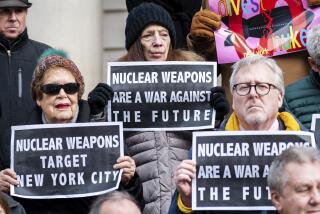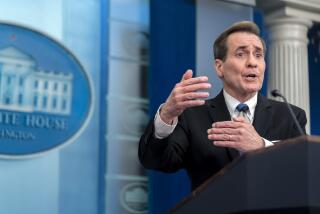Carlucci Rejects Soviet Claim on Military Policy
- Share via
MOSCOW — Defense Secretary Frank C. Carlucci told top Soviet military officers here Monday that he has seen no evidence to support Moscow’s claim that it has adopted a defensive strategy.
The United States, Carlucci said, will as a consequence continue strengthening its own military capability, striving particularly to widen its technological lead in weaponry over the Soviet Union.
Carlucci, beginning an unprecedented four days of talks with Soviet leaders and visits to secret military bases, made clear the Pentagon’s reluctance to believe that its principal adversary has changed its strategy and tactics and that the United States now needs to respond with a matching policy shift.
Blunt Speech at Staff College
“We have difficulty reconciling a (military) defense doctrine with what we see in Soviet force structure and operational strategy as an emphasis on the offensive,” Carlucci declared in a blunt speech to the Soviet general staff’s special military staff college. “We see no shift of emphasis to the kind of forces traditionally associated with defense.”
Carlucci made a point of both the large concentration of Soviet forces in Central Europe, where Moscow’s forces have a large advantage in its tank units, and the continued deployment of large SS-18 intercontinental ballistic missiles that Washington assumes are aimed at U.S. nuclear missile facilities.
“We recognize that the Soviet Union has legitimate defense needs, and we are aware of the suffering your country has endured in the past,” Carlucci told 200 senior Soviet officers. “No one begrudges you the need for a strong and capable army.
“What troubles us is when the Soviet Union continues to develop forces far in excess of what it needs for purposes of its own defense, especially when that newly added strength focuses on forces designed for massive offensive operations to seize and hold territory.”
Carlucci told the officers the United States found it difficult to reconcile Moscow’s pledge not to be the first to use nuclear weapons “with your continuing emphasis on heavy ICBMs (inter-continental ballistic missiles), such as the SS-18.”
“These missiles, in our view, are best suited for a first strike against U.S. silo-based systems--a capability more compatible with a military doctrine that emphasises preemptive nuclear strikes,” Carlucci said.
“I recognize, of course, that significant changes in force structure can take time to implement. But I am equally sure you will recognize that no prudent military man would alter his own posture until he saw evidence of actual change.”
A tough-minded professional in national security, Carlucci was clearly seeking to challenge current Soviet thinking on the strategic balance of power and to push Moscow into bigger and faster changes.
“I am speaking candidly because I am convinced that candor is constructive,” Carlucci said. “Dialogue, after all, enhances our security. . . .
“The way to advance the Soviet-American dialogue is not to paper over our differences, but to face them squarely, search for common ground and build on it.”
In his speech, Carlucci told the officers that the Strategic Defense Initiative, known as “Star Wars,” bitterly criticized here as threatening an escalation of the arms race and ultimately the strategic balance and peace, “is purely defensive and does not represent the slightest threat to the Soviet Union.”
Calling the United States an island nation, he addressed another area of Soviet concern over U.S. intentions and urged his audience to appreciate the need for a large navy to protect U.S. lifelines to trading partners.
“Your leaders are now urging us to reduce our naval forces. But asking the United States to cut back its naval capabilities would be similar to asking the Soviet Union to tear up its road system and railways,” Carlucci said.
And he said he recognized significant change was under way in the Soviet Union but sought to know whether the policies of glasnost, or openness, of Kremlin leader Mikhail S. Gorbachev “will ease the secrecy surrounding the Soviet military.”
Soviet officials plan to open up three of their most secure military and naval bases for Carlucci over the next three days, and he has been promised that he would be shown the Blackjack strategic bomber, counterpart of the American B-1.
Must Work Together
“We must continue to work together to find ways to prevent dangerous military incidents that might spark a confrontation neither of us wants,” Carlucci said, calling for greater military openness between the two countries.
In a 20-minute, equally blunt question-and-answer session after the speech, Carlucci defended the size of the U.S. Navy and the Pentagon’s doctrine of deterrence through adequate armed forces and weaponry.
“From our point of view, and I say this with all sincerity, there is no threat to the Soviet Union,” he told one admiral in the audience. “Our (strategic) doctrine is one of deterrence, to dissuade the other side from attacking. It is not a doctrine that threatens the Soviet Union or any other country.”
Visit to Bases
Carlucci and his aides will see the Taman army base and Kubinka air field, both near Moscow, today. They are to visit naval bases in the Crimea on Wednesday and leave for Turkey the next day. Carlucci said he believes that he and Gen. Dmitri T. Yazov, the Soviet defense minister, could be more candid with each other than other high-level officials because “we are soldiers.”
He told the cadets at the giant octagonal staff academy, somewhat similar to a U.S. war college, that the Soviet Union spends between 15% and 17% of its gross national product on the military compared to annual U.S. spending of 5.7% of GNP.
But most important, he said, the U.S. defense budget “is not hidden from public view” as the Soviet budget has been.
More to Read
Sign up for Essential California
The most important California stories and recommendations in your inbox every morning.
You may occasionally receive promotional content from the Los Angeles Times.










